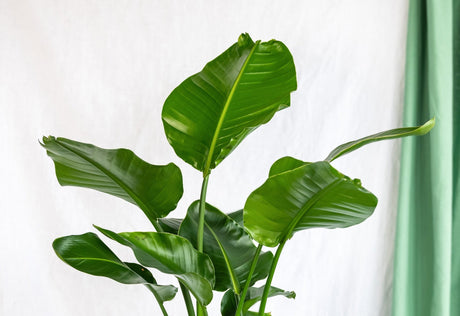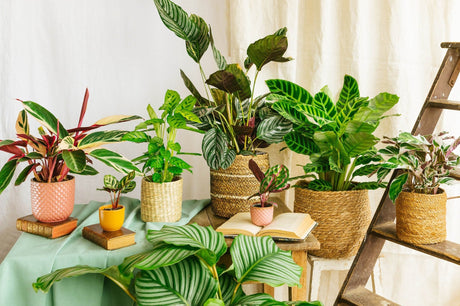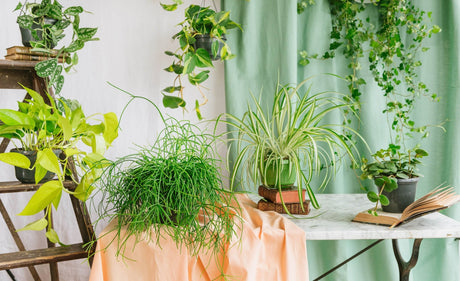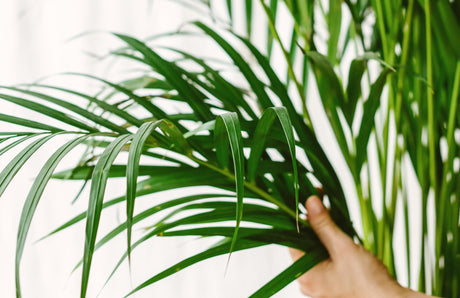Marantas are distinguished by their intricately patterned oval leaves which can vary from bright green to dark red , often enhanced with unique markings in the shape of arrows or bands. The leaves close at night as if in prayer, hence the nickname "prayer plant".
Among the most captivating varieties are the Maranta leuconeura fascinator, the Maranta Lemon Lime
1. Watering the Maranta
Irrigation is one of the most critical aspects of maintenance of Maranta, a plant that thrives in conditions humid.The water needs of the Maranta can vary depending on the season. During the months warmer and more bright, it may require more watering frequent, while during winter, when growth is more slow, you should water less often.
Tip : Iinsert your finger into the ground to approximately 2-3 centimeters of depth. If the soil is dry at this level, it is time to water.Avoid overwatering, as the roots of Maranta are susceptible to rot.
2. Watering techniques
Watering from below
Place the pot in a shallow saucer filled with water. Allow the soil to absorb the water by capillary action for about 20 to 30 minutes, then drain the excess water from the saucer. This method prevents sensitive roots from being constantly soaked, which could lead to rot.Partial soaking technique
A variation of watering from below is to partially submerge the pot in a container of water for a short time. This allows the roots to absorb moisture without undue stress.Watering with a spouted watering can
Use a bottle with a thin tip or a watering can with a narrow spout to water the soil directly around the plant. This allows precise watering without overwetting the leaves.3. The Exhibition of Maranta
Place your Maranta in a place bright , but avoid sunlight direct. Direct rays from the sun can burn delicate leaves and damage their appearance .If possible, use light curtains or blinds to filter the light of the sun and reduce its intensity while maintaining a luminous atmosphere.
4. When should I repot my Maranta?
Repotting is an essential step in caring for the Maranta, making it possible to guarantee a space adequate for its roots in growth and to maintain its health global.The ideal time to repot your Maranta is usually spring or at the beginning of summer, when the plant enters its period of growth active. At that time, the plant will be better equipped to establish itself quickly in its new pot and adapt to its new environment.
The signs indicating a need for repotting:
Root crowding
If you notice that the roots of the Maranta are starting to come out of the drainage holes in the current pot, it's time to repot.Slowed growth
If your Maranta stops growing, produces fewer new leaves, or appears less vigorous overall, it may be a sign that its roots are lacking space and nutrients.Increased watering frequency
If you have to water your Maranta more frequently than usual because the soil dries out quickly, this may indicate that the pot has become too small to hold enough water.5. What fertilizer should I use for my Maranta?
Proper nutrition is essential to ensure growth lush and t1>health of your Maranta.Go for a fertilizer liquid balanced for plants indoor.Application frequency
During the active growing season (spring and summer), apply fertilizer every 4-6 weeks. Reduce frequency during fall and winter months when growth slows. Always follow the instructions on the fertilizer label to determine the proper amount to use.Watering before application
Water your Maranta lightly before applying fertilizer. This will help avoid excessive concentration of fertilizer in the soil and prevent the risk of root burns.6. How do I multiply my Maranta?
You can multiply your Maranta using the method division. Here's how.Choose a plant mature and good healthy for division. Gently separate the clumps of roots by dividing them into smaller sections, ensuring that each section has roots and leaves. Use a clean, sterilized knife to cut the sections if necessary.
Fill new
7. Diseases of Maranta
The Marantas, while robust, can be prone to some problems from health. Here is a list of diseases and problems common that your Maranta might experience :
Root rot
Overwatering or poor drainage can lead to root rot, which manifests as yellowing, wilting leaves. Make sure the soil dries out slightly between waterings.
Mildew
Downy mildew is a fungus that can affect Maranta leaves, causing yellow and brown spots with a powdery appearance. Avoid overwatering and ensure good air circulation.
Leaf spots
Brown or black spots on the leaves may indicate a fungal infection. Avoid watering the leaves and make sure they stay dry.
Spotted leaves
White, yellow or brown spots on the leaves may indicate attacks by mites or scale insects. Use a mild insecticidal soap to treat them.
Leaf discoloration
Excessive sun exposure can cause the leaves to become discolored, while lack of light can make them pale and stretched. Adjust the exposure accordingly.
Chlorosis
Leaves that turn yellow with green veins can indicate a nutrient deficiency, such as iron. Use a balanced fertilizer to correct this problem.
Wither
Dry air can cause Maranta leaves to wilt. Increase ambient humidity by using water trays or humidifiers.
Aging of leaves
Older Maranta leaves eventually turn yellow and die naturally. This is a normal process, but remove them to encourage new leaf growth.
8. Delivery and receipt of your plant
- Your plant is dry
- Is your plant wet ? Let the potting soil dry.
- Should I repot my plant right away ? No ! Wait until next spring or for signs that your plant needs repotting.






